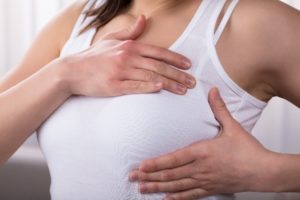 Although most breast enhancement patients are delighted with their results, in rare cases patients may be dissatisfied because the breast implants harden after breast augmentation surgery. This usually does not happen in my practice because of the multiple things done in the operating room that reduce the risk of contracture. These would include placing the implant behind the pectoralis major muscle, soaking the implants in antibiotic solution, washing out the area where the implant will go with antibiotic solution, administering intravenous antibiotics to the patient, and preventing contact between the implant and skin when I insert the implant by the use of a sterile plastic skin covering. When firmness does occur, though, how do I treat it?
Although most breast enhancement patients are delighted with their results, in rare cases patients may be dissatisfied because the breast implants harden after breast augmentation surgery. This usually does not happen in my practice because of the multiple things done in the operating room that reduce the risk of contracture. These would include placing the implant behind the pectoralis major muscle, soaking the implants in antibiotic solution, washing out the area where the implant will go with antibiotic solution, administering intravenous antibiotics to the patient, and preventing contact between the implant and skin when I insert the implant by the use of a sterile plastic skin covering. When firmness does occur, though, how do I treat it?
First of all, firmness of the breasts is not caused by a hardening of the implant. When one removes an implant in a patient with firmness, the implant is still very soft. Firmness results from a contracture of the scar tissue that is present around every breast implant. As this scar tissue squeezes down on the implant it becomes firm to touch, is sometimes painful, and usually changes the implant shape from a soft pillow to a hard ball.
To treat the firmness, the first thing I do is to start the patient on Singulair, an asthma medication that will tend to relax the contracture. This off-label use of Singulair may be successful. If it is not working after 3 months, we may to consider an additional operation to release the contracture. If the contracture started right after surgery, a simple incision of the scar tissue will release the tightness and may be all that is required. If the contracture started years after the surgery, it will usually be necessary to surgically remove the scar tissue and change implants as well. If the implant is not behind the muscle, I like to move it there since this will help to prevent a return of the contracture.
What happens if none of these steps are successful? There is now something available, known as an Acellular Dermal Matrix and marketed as Alloderm or Strattice. This is nothing more than skin from a human or a pig. It has been treated so as to remove all cells so that just the collagen framework remains. This can be used in surgery after the scar tissue is excised to cover the part of the implant that is not covered by the muscle. Early studies are showing that this may be of help in preventing the return of the contracture. It is very expensive, however, so that I usually reserve this for cases of contracture that do not respond to simple removal of scar tissue.
Although breast hardening after implant surgery is troublesome, Dr. Sanders can manage the condition and provide patients with successful treatment. Should you desire more information, please contact my Los Angeles plastic surgery office.





